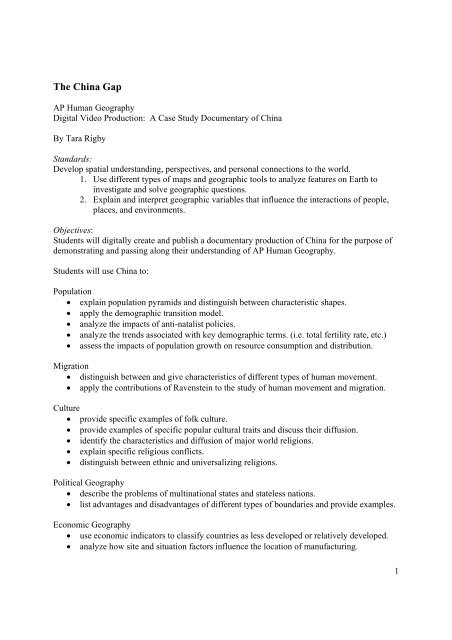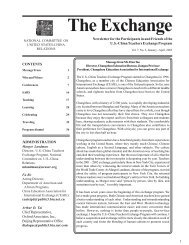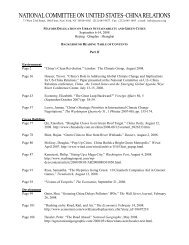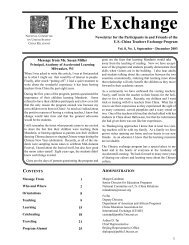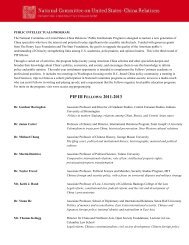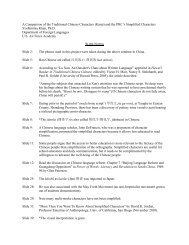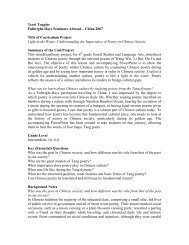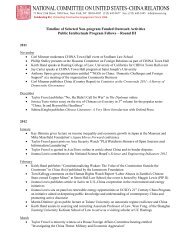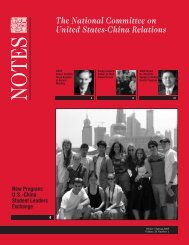The China Gap-Digital Video Production (AP Human
The China Gap-Digital Video Production (AP Human
The China Gap-Digital Video Production (AP Human
Create successful ePaper yourself
Turn your PDF publications into a flip-book with our unique Google optimized e-Paper software.
<strong>The</strong> <strong>China</strong> <strong>Gap</strong><br />
<strong>AP</strong> <strong>Human</strong> Geography<br />
<strong>Digital</strong> <strong>Video</strong> <strong>Production</strong>: A Case Study Documentary of <strong>China</strong><br />
By Tara Rigby<br />
Standards:<br />
Develop spatial understanding, perspectives, and personal connections to the world.<br />
1. Use different types of maps and geographic tools to analyze features on Earth to<br />
investigate and solve geographic questions.<br />
2. Explain and interpret geographic variables that influence the interactions of people,<br />
places, and environments.<br />
Objectives:<br />
Students will digitally create and publish a documentary production of <strong>China</strong> for the purpose of<br />
demonstrating and passing along their understanding of <strong>AP</strong> <strong>Human</strong> Geography.<br />
Students will use <strong>China</strong> to:<br />
Population<br />
• explain population pyramids and distinguish between characteristic shapes.<br />
• apply the demographic transition model.<br />
• analyze the impacts of anti-natalist policies.<br />
• analyze the trends associated with key demographic terms. (i.e. total fertility rate, etc.)<br />
• assess the impacts of population growth on resource consumption and distribution.<br />
Migration<br />
• distinguish between and give characteristics of different types of human movement.<br />
• apply the contributions of Ravenstein to the study of human movement and migration.<br />
Culture<br />
• provide specific examples of folk culture.<br />
• provide examples of specific popular cultural traits and discuss their diffusion.<br />
• identify the characteristics and diffusion of major world religions.<br />
• explain specific religious conflicts.<br />
• distinguish between ethnic and universalizing religions.<br />
Political Geography<br />
• describe the problems of multinational states and stateless nations.<br />
• list advantages and disadvantages of different types of boundaries and provide examples.<br />
Economic Geography<br />
• use economic indicators to classify countries as less developed or relatively developed.<br />
• analyze how site and situation factors influence the location of manufacturing.<br />
1
• discuss the problems created by industrialization.<br />
• evaluate the impacts of development on resource consumption and subsequent policies.<br />
Project Narrative<br />
<strong>The</strong> greatest impact from studying in <strong>China</strong> will be felt within the classroom. Since my<br />
district has undergone changes in graduation requirements in an effort to better prepare students<br />
for the 21 st century, I want my project plan to align well with these desired outcomes. <strong>The</strong> stated<br />
need from our district is for students to “demonstrate competency of Real World Applications,<br />
Creative Applications, Critical Thinking, Decision Making, Advocacy, and Adaptations to everchanging<br />
personal and global contexts…” (Poudre School District Graduation Requirements).<br />
By designing a project that will incorporate these necessary skills along with the knowledge and<br />
understanding of <strong>China</strong>’s role in our changing world, students will emerge better prepared to<br />
face the challenges of modern society. <strong>The</strong> following project is specifically designed for High<br />
School level students enrolled in Advanced Placement <strong>Human</strong> Geography.<br />
<strong>The</strong> <strong>Human</strong> Geography curriculum is thematic in nature and focuses on theories and<br />
models that can be applied to all regions of the world. At the onset of this project, students will<br />
have completed instruction in all of the areas featured in the case study. In addition, students will<br />
have developed skills in the spatial analysis of a variety of concepts. <strong>The</strong>refore, the objective is<br />
to assess their level of mastery over the content as they apply their understanding specifically to<br />
<strong>China</strong>. For <strong>Human</strong> Geography, this would be completed as an end of year assessment.<br />
My project plan focuses on technology and writing. Within this framework, students will<br />
be required to work collaboratively with a partner to coordinate their knowledge of <strong>China</strong>’s<br />
changing position within our global society. Through the process of digital video production,<br />
students will use <strong>China</strong> as a case study example to demonstrate their knowledge of culture,<br />
population, migration, political geography, economic geography, and resource issues. <strong>Digital</strong><br />
video production utilizes voiceover technology to inform an audience while using photos or<br />
video resources to enhance the vocal narration. Students will be required to evaluate what they<br />
have learned throughout the year and assess what areas are the most significant within each of<br />
the required categories. <strong>The</strong>y will need to select visual cues to help them represent their selected<br />
topics. <strong>The</strong>n, through the process of writing and editing, they will develop a narrative to<br />
accompany the photo or video segments within their story. Applications that can be used for this<br />
2
project include such prepackaged programs as iMovie for Macs, Movie Maker for PCs, or a free<br />
download program called Photo Story 3 for PC users.<br />
<strong>The</strong> process of digital video production requires students to execute the writing process<br />
while simultaneously collaborating with peers and mastering a form of technology. This will<br />
allow students to participate in the creation of a piece of writing that will require both personal<br />
and peer revision (DeVoss, et.al., 2010). Ultimately, the result will be a product that has been<br />
designed through negotiations among diverse individuals.<br />
Students must be mindful that their purpose is to inform an audience of <strong>China</strong>’s<br />
experience through the eyes of a geographer. <strong>The</strong>ir product will be digitally published for the<br />
availability of a wider audience of parents and peers. <strong>The</strong>y are not simply creating a report to be<br />
viewed exclusively by their instructor. Instead, we will allow fellow students and parents to<br />
view the finished stories online and provide positive feedback to the creators.<br />
Through the development of 21 st century skills, students will be able to thrive in an ever<br />
changing global community. By exploring <strong>China</strong>’s dynamic role in the world today, students<br />
can apply writing techniques and peer collaboration methods through the use of technology to<br />
demonstrate learning. As an educator, I look forward to guiding my students as they learn what<br />
it means to move ahead with confidence.<br />
Work Cited<br />
3
DeVoss, D.N., Eidman-Aadahl, E., & Hicks, T. (2010). Because <strong>Digital</strong> Writing Matters:<br />
Improving Student Writing in Online and Multimedia Environments. San Francisco:<br />
Jossey-Bass.<br />
Learning Activities<br />
<strong>The</strong> theme of this project is, “<strong>The</strong> <strong>China</strong> <strong>Gap</strong>”. This refers to the dramatic divide linked<br />
to a variety of features within <strong>China</strong>. Specifically, students will be addressing one of the<br />
following “gaps”: the generation gap, the culture gap, the ethnicity gap, the resource gap, the<br />
political gap, the economic gap, the gender gap, or the development gap. Include in this project<br />
packet are the following resources: 1) student instructions, 2) project guides, 3) instructor’s<br />
guide, 4) student planning page, 5) peer review guide, and 6) a student reflective question.<br />
1) Student Instructions<br />
This handout provides step-by-step instructions to students. It introduces them to the overall<br />
theme of the project and the resources that will accompany their planning.<br />
2) Project Guides<br />
This handout is specific to each “gap”. It provides students with a list of elements to consider in<br />
the creation of their project. This guide will give them a better sense of how the project will be<br />
graded. In addition, there are helpful resources designed to guide students’ thinking. Included<br />
here are relevant units of study, key terms, and recommended resources for each topic.<br />
3) Instructor’s Guide<br />
<strong>The</strong> instructor’s guide is specifically designed to assist teachers. Each “gap” is explained to<br />
provide context and relevant background information. <strong>The</strong>se thoughts were compiled based on<br />
my study abroad experience, as well as my years of teaching <strong>Human</strong> Geography inside the<br />
classroom. <strong>The</strong> information here should not be considered all inclusive since students may<br />
discover different angles from which to approach the content. For additional ideas, visit the<br />
provided sources.<br />
4) Student Planning Page<br />
This resource can be most closely associated with a story board. It is used for planning a digital<br />
production and should be distributed to students electronically. <strong>The</strong>y can manipulate the margins<br />
4
and duplicate the template as needed. Here they will create their written narrative and associate<br />
it with visual details. <strong>The</strong>y should also use it as a place to keep track of sources.<br />
5) Peer Review Guide<br />
This is a guide for students as they share their digital productions with one another. <strong>The</strong> learning<br />
for the project should not be limited to their personal case study topic. Instead, they will share<br />
their productions with one another, provide feedback, and evaluate the content from a geographic<br />
perspective. Since there are likely to be numerous video productions, it may be necessary to<br />
have students view and assess them digitally on their own. <strong>The</strong> instructor can then select the<br />
most effective productions to later view in class.<br />
<strong>The</strong> Peer Review Guide is also a useful tool for students as they are going through the process of<br />
planning and creating their own projects. Knowing how they will be evaluated is essential for<br />
the creation of quality products. I would also suggest that this guide be used as a rubric for<br />
teachers. Assign a maximum score to each line of questioning and use it to help guide your<br />
evaluation.<br />
6) Student Reflective Question<br />
This is an opportunity for students to synthesize their learning. I suggest that it be administered<br />
as an in-class, handwritten, final culmination of the project. It is essential that students draw<br />
connections and have time to reflect on the value of the learning process.<br />
5


